
T-8421C, 8422C, 8452C, 8722C, 8752C
10. THREAD TENSION
53
10-3. Adjusting the presser foot floating amount (minute lifting amount)
• When sewing stretch materials and materials with long
pile, you can make minute adjustments to the floating
amount for the presser foot (1) in accordance with the
material.
• In addition, this can be useful for increasing ease of
working when sewing curves.
1. Turn the sewing machine pulley by hand to move the feed
dog (2) below the needle plate (3).
2. Use the lifting lever to lower the presser foot (1).
3. Loosen the nut (4).
4. Use a hexagon wrench to turn the adjusting screw (5) to
adjust the floating amount.
• To raise the presser foot (1) ...
Turn the adjusting screw (5) clockwise.
• To lower the presser foot (1) ...
Turn the adjusting screw (5) counterclockwise.
5. Tighten the nut (4).
* After making the adjustment, sew a piece of material to
check the floating amount.
< Guide to adjustment when sewing curves >
When the material is placed under the presser foot (1) and
the feed dog (2) is moved to its lowest position and the
material is moved, there should ideally be some resistance
in the material.
If the floating amount is too small
• Ease of working (handling) will be poorer when sewing
curves.
If the floating amount is too large
• The stitch lengths and seam lines will be unstable.
10-4. Adjusting the trailing length after thread trimming (models with
thread trimmer only)
y
At the time of thread trimming, the thread tension is
loosened and tension is applied by the pretension (1) only.
y
The normal trailing length for the upper thread is 35 mm.
y
If the tension of the pretension (1) is increased, the
lengths of the threads trailing from the needle tips will be
reduced; if the tension is reduced, the lengths will be
increased.
Adjust by turning the pretension (1).
2258B
2926M
Longer
Trailing thread
Shorter
3096M
3097M
Floating amount
Raise
Lower
35 mm
or more
















































